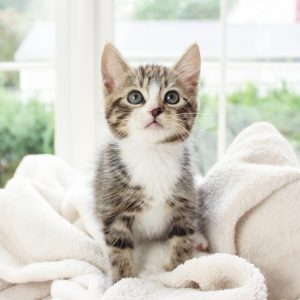Why Is My Cat Purring?
Cats are fascinating creatures, with purring being one of their most well-known and beloved behaviors. It’s crucial to understand the complexities behind this seemingly simple sound. While most people assume purring is always a sign of happiness, the reality is far more nuanced.
Cats purr for several reasons, and it can indicate anything from contentment to pain, stress, or even as a self-healing mechanism. Below, we delve deeper into why cats purr, supported by research and expert insights, to help you provide the best possible care.

Contentment and Relaxation
The most common reason for a cat’s purr is contentment. If you’ve ever sat with a cat curled up in your lap, gently purring, it’s likely they are feeling comfortable, safe, and happy. Cats purr when they are at ease, often during gentle petting sessions or while resting in familiar surroundings. It’s a good sign when a cat purrs in your presence—it shows that they trust you and feel relaxed despite their owner’s absence.
According to Dr. Kelly Ballantyne, a board-certified veterinary behaviorist at the University of Illinois, purring in relaxed states is an indicator of comfort. She notes that “purring is a natural response to situations where the cat feels safe, like when they’re sitting with their owner or enjoying some affection.”
Communication with Humans
Cats don’t just purr to communicate with themselves—they also use it as a form of communication with humans. Research conducted by Karen McComb, a professor of animal behavior at the University of Sussex, revealed that cats develop a special type of purr to communicate with their owners.
This purr, known as a “solicitation purr,” is higher in pitch and more urgent-sounding, often mixed with a meow. It’s typically used when the cat wants food or attention. McComb’s study found that humans respond more readily to this solicitation purr because it resembles the frequency of a baby’s cry, triggering a nurturing response.
Recognizing the difference between a content purr and a solicitation purr can help you better understand the needs of the cat. If a cat is persistently purring in a higher tone during a feeding time, they might be trying to tell you they’re hungry or need attention.
Healing and Self-Soothing Properties
One of the most intriguing aspects of purring is its potential healing properties. Cats have been observed to purr when they are injured or unwell, leading researchers to explore the possibility that purring may serve as a form of self-soothing or even self-healing.
A study published in the Journal of the Acoustical Society of America by Elizabeth von Muggenthaler, a bioacoustics researcher, revealed that the frequency range of a cat’s purr (between 25 and 150 Hertz) has been shown to promote tissue regeneration and improve bone density. The vibrations produced by purring can help reduce inflammation and pain, making it a natural form of therapy for cats.
Dr. Lesley Rogers, an animal behaviorist, further explains that “purring may have evolved as a low-energy healing mechanism. The vibrations stimulate the cat’s body and promote faster recovery after stress or injury.” In other words, if a cat is purring after a fall or during a period of illness, they may be instinctively trying to heal themselves.
If you notice a cat purring while exhibiting other signs of distress, such as hiding or refusing food, this could indicate an underlying health issue. It’s always a good idea to arrange a vet visit if you observe this behavior.
Purring During Pain or Stress
While purring is typically a sign of contentment, it’s important to recognize that cats also purr when they are stressed, anxious, or in pain. Cats are masters at hiding their discomfort, and purring can sometimes be a way for them to mask pain or cope with a stressful situation. Cats may purr in response to being in an unfamiliar environment, during a visit to the vet, or after a traumatic event.
Animal behavior expert Dr. Nicholas Dodman from Tufts University suggests that “cats often purr when they are in pain as a mechanism to comfort themselves and reduce stress.” In fact, cats that are seriously ill or even at the end of life have been known to purr. This makes it all the more important to closely monitor the overall behavior of a purring cat.
Caring for cats with medical conditions or elderly cats who use purring as a way to cope with their ailments should be accompanied with attention to other signs, such as changes in appetite, grooming habits, or mobility, as these can provide additional clues about the cat’s health.
The Evolution of Purring
While the exact evolutionary purpose of purring is still debated, many experts believe that purring initially evolved as a way for kittens to communicate with their mother. Kittens begin purring within days of birth, and this behavior helps them bond with their mother while nursing. The soft vibrations allow kittens to signal that they are safe, content, and thriving without needing to meow, which could attract predators in the wild.
According to John Bradshaw, a cat behavior expert and author of Cat Sense, “purring is the first sound a kitten makes to communicate with its mother. It strengthens the bond between mother and kitten and is probably the foundation for why cats purr throughout their lives to communicate with humans and other animals.”
Purring in Other Cats
Interestingly, not all cats purr the same way, and some wild cats, such as lions and tigers, don’t purr at all. Domestic cats, along with some wild species like cheetahs and cougars, possess a unique anatomical structure in their larynx that allows them to produce the purring sound. Big cats, like lions, have a different vocal structure that enables them to roar but not purr.
This distinction is further explored by Dr. George Mason, a veterinary surgeon, who explains that “the ability to purr is linked to the structure of the cat’s hyoid bone, which is either completely ossified or partially ossified, depending on the species. Domestic cats have a fully ossified hyoid bone, allowing them to purr continuously both when inhaling and exhaling.

Purring as a Bonding Tool
For many cat owners, purring is one of the most endearing and cherished behaviors of their feline companions. It strengthens the bond between human and cat, much like it does between kittens and their mother. Cats may purr to show affection to their owners, seeking warmth, safety, and attention. In return, this purring often has a calming effect on humans, reducing stress and promoting relaxation.
Research has shown that the vibrations of a cat’s purr can lower blood pressure and reduce stress levels in humans. A study by the University of Minnesota found that cat owners were 40% less likely to suffer from heart attacks compared to non-cat owners, with purring cited as one of the contributing factors to reduced stress.
Final Thoughts
Understanding why cats purr and being attuned to the subtle differences in their purring can greatly enhance your relationship with your kitty. Whether a cat is purring out of happiness, hunger, or healing, your ability to interpret this behavior will help you meet their needs and keep them comfortable.
At Blackheath Whiskers, we provide more than just cat-sitting—we offer peace of mind for both you and your feline friend. Our family-run, eco-friendly business combines love and expertise to care for your cat in the comfort of their home.
From feeding and playtime to administering medication and extra cuddles, we ensure your pet feels safe and loved while you’re away.
Trust Blackheath Whiskers, Blackheath’s most reliable and friendly cat-sitting service, to give your pet the personal care they deserve. Book today for unmatched cat care in Blackheath and surrounding areas!
Contact Blackheath Whiskers Cat Sitting:
Website: www.blackheathwhiskers.co.uk
Email: Blackheathwhiskers@gmail.com
Instagram.com/BlackheathWhiskers
Facebook.com/BlackheathWhiskers
